西安旅游景点 英语 急!~~,西安旅游景点英文翻译
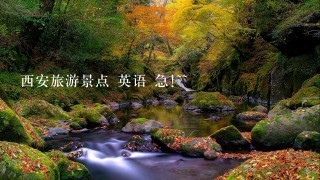
1、西安旅游景点 英语 急!~~
Wild Goose Pagoda North Square Xing Qinggong,xing qingpalace 才看到哦。
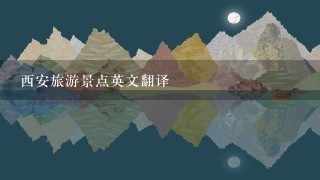
2、西安旅游景点英文翻译
Xi'an tourism on Lishan Lishan in Lintong County of Xi'an South, is a spur of the Qinling Mountains. Top peak Kowloon 1301.9 meters above sea level, the mountain pine Bai Changqing, a lush, green Yuankan the shape of a horse Li, Gu Ming, "Li Shan." Li Shan Tsui show because of scenery, the United States such as Fairview Park, it also known as "embroidered Ridge." When the sun sets, Li Huiying Hill in the golden sunset glow, especially Qili scenery, "Li Shan night as" good reputation. Lishan beautiful scenery, since ancient times, has always been a place tourists want to visit. A level road up the mountain over 3,200 meters, first came to the hillside Lishan "Banhu Stone", will see soldiers remonstrance Pavilion, to commemorate the Xi'an Incident built. After straight on the peaks to the west "as late booths." Standing kiosks in the north, the Hua Qing Hot Spring in sight at a glance. Then forward it to the West Ridge embroidered on the third-Lao Jundian. Laojun that I, for the well-known Lishan Road instructors concept. Legend has it, Emperor Xuanzong twice in the Laojun see this coming Genei, it called down St. Court, also known as Chaoyuan Club. Diannei Baiyu Laojun like the original houses, "An-Shih Rebellion", like the crack whilst physically burned, his hands also were stolen, are now preserved in the Shaanxi-like museum. To the east by the Lao Jundian, embroidered on the West Ridge to the second peak on the "mother Temple." This palace is a historical legends of the Nvwo built. Further east to west embroidered Ridge will be the first peak on the beacon towers. The history of "War drama诸侯, missing the world laugh," the story occurred here. Legend has it that week to win Aifei pao You Wang Si laugh, have fun here cite the War诸侯. When Quanrong scored Lishan, You Wang then ordered to ignite flames, but people诸侯Laijiu, You Wang was killed, pao SI been taken, the Western Zhou Dynasty extinction. After the beacon towers over the East to the east that is embroidered Lingshang the "stone urn Temple." Temple due to the impact of western rock by flowing water and shaped urn, the name "stone urn Temple." According to legend, a temple built in the Tang first year, with the remainder making Qinggong, the materials be built. Then things embroidered Ling arrived at between the stone Weng Valley "event of Xian Qiao." It is said that this bridge was built in Tang Dynasty, is a five meters long, 2.4 meters wide and five meters high stone arch bridge in one hole. Legend has it that the ancient one candidate, Gankao trip to Beijing this bridge, in the immortal advice, lucky examinations, the bridge of this "event of Xian Qiao."。

3、西安旅游景点英文翻译
推荐使用ubuntu 12.04。
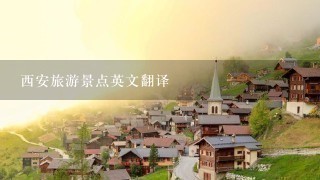
4、西安旅游景点英文翻译
Xi'an tourism on Lishan Lishan in Lintong County of Xi'an South, is a spur of the Qinling Mountains. Top peak Kowloon 1301.9 meters above sea level, the mountain pine Bai Changqing, a lush, green Yuankan the shape of a horse Li, Gu Ming, "Li Shan." Li Shan Tsui show because of scenery, the United States such as Fairview Park, it also known as "embroidered Ridge." When the sun sets, Li Huiying Hill in the golden sunset glow, especially Qili scenery, "Li Shan night as" good reputation. Lishan beautiful scenery, since ancient times, has always been a place tourists want to visit. A level road up the mountain over 3,200 meters, first came to the hillside Lishan "Banhu Stone", will see soldiers remonstrance Pavilion, to commemorate the Xi'an Incident built. After straight on the peaks to the west "as late booths." Standing kiosks in the north, the Hua Qing Hot Spring in sight at a glance. Then forward it to the West Ridge embroidered on the third-Lao Jundian. Laojun that I, for the well-known Lishan Road instructors concept. Legend has it, Emperor Xuanzong twice in the Laojun see this coming Genei, it called down St. Court, also known as Chaoyuan Club. Diannei Baiyu Laojun like the original houses, "An-Shih Rebellion", like the crack whilst physically burned, his hands also were stolen, are now preserved in the Shaanxi-like museum. To the east by the Lao Jundian, embroidered on the West Ridge to the second peak on the "mother Temple." This palace is a historical legends of the Nvwo built. Further east to west embroidered Ridge will be the first peak on the beacon towers. The history of "War drama诸侯, missing the world laugh," the story occurred here. Legend has it that week to win Aifei pao You Wang Si laugh, have fun here cite the War诸侯. When Quanrong scored Lishan, You Wang then ordered to ignite flames, but people诸侯Laijiu, You Wang was killed, pao SI been taken, the Western Zhou Dynasty extinction. After the beacon towers over the East to the east that is embroidered Lingshang the "stone urn Temple." Temple due to the impact of western rock by flowing water and shaped urn, the name "stone urn Temple." According to legend, a temple built in the Tang first year, with the remainder making Qinggong, the materials be built. Then things embroidered Ling arrived at between the stone Weng Valley "event of Xian Qiao." It is said that this bridge was built in Tang Dynasty, is a five meters long, 2.4 meters wide and five meters high stone arch bridge in one hole. Legend has it that the ancient one candidate, Gankao trip to Beijing this bridge, in the immortal advice, lucky examinations, the bridge of this "event of Xian Qiao."。
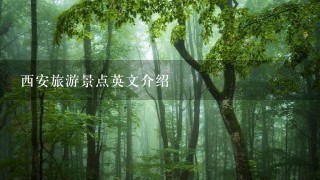
5、西安旅游景点英文介绍
Big Wild Goose Pagoda Originally built in 652 during the reign of Emperor Gaozong of the Tang Dynasty (618-907), it functioned to collect Buddhist materials that were taken from India by the hierarch Xuanzang. Xuanzang started off from Chang'an (the ancient Xian), along the Silk Road and through deserts, finally arriving in India, the cradle of Buddhism. Enduring 17 years and traversing 100 countries, he obtained Buddha figures, 657 kinds of sutras, and several Buddha relics. Having gotten the permission of Emperor Gaozong (628-683), Xuanzang, as the first abbot of Da Ci'en Temple, supervised the building of a pagoda inside it. With the support of royalty, he asked 50 hierarchs into the temple to translate Sanskrit in sutras into Chinese, totaling 1,335 volumes, which heralded a new era in the history of translation. Based on the journey to India, he also wrote a book entitled 'Pilgrimage to the West' in the Tang Dynasty, to which scholars attached great importance. First built to a height of 60 meters (197 feet) with five stories, it is now 64.5 meters (211.6 feet) high with an additional two stories. It was said that after that addition came the saying-'Saving a life exceeds building a seven-storied pagoda'. Externally it looks like a square cone, simple but grand and it is a masterpiece of Buddhist construction. Built of brick, its structure is very firm. Inside the pagoda, stairs twist up so that visitors can climb and overlook the panorama of Xian City from the arch-shaped doors on four sides of each storey. On the walls are engraved fine statues of Buddha by the renowned artist Yan Liben of the Tang Dynasty. Steles by noted calligraphers also grace the pagoda. As for the reason why it is called Big Wild Goose Pagoda, there is a legend. According to ancient stories of Buddhists, there were two branches, for one of which eating meat was not a taboo. One day, they couldn't find meat to buy. Upon seeing a group of big wild geese flying by, a monk said to himself: 'Today we have no meat. I hope the merciful Bodhisattva will give us some.' At that very moment, the leading wild goose broke its wings and fell to the ground. All the monks were startled and believed that Bodhisattva showed his spirit to order them to be more pious. They established a pagoda where the wild goose fell and stopped eating meat. Hence it got the name 'Big Wild Goose Pagoda'. The Terracotta Army (Chinese: 兵马俑; Pinyin: Bīng Mǎ Yǒng; literally "military servants") or Terra-cotta Warriors and Horses is a collection of 8,099 life-size terra cotta figures of warriors and horses located in the Mausoleum of the First Qin Emperor (秦始皇陵; Qín Shǐ Huáng Líng). The figures were discovered in 1974 near Xi'an, Shaanxi province, The terracotta figures were buried with the first Emperor of Qin (Qin Shi Huang) in 210-209 BC. Consequently, they are also sometimes referred to as "Qin's Army." The Terracotta Army of China was discovered in March 1974 by local farmers drilling a well to the east of Mount Li. Mount Li is the name of the man-made necropolis and tomb of the First Emperor of Qin; Qin Shi Huang. Construction of this mausoleum began in 246 B.C. and is believed to have taken 700,000 workers and craftsmen 36 years to complete. Qin Shi Huang was interred inside the tomb complex upon his death in 210 B.C. According to the Grand Historian Sima Qian, The First Emperor was buried alongside great amounts of treasure and objects of craftsmanship, as well as a scale replica of the universe complete with gemmed ceilings representing the cosmos, and flowing mercury. representing the great earthly bodies of water. Recent scientific work at the site has shown high levels of mercury in the soil of Mount Li, tentatively indicating an accurate description of the site’s contents by Sima Qian. The tomb of Qin Shi Huang is near an earthen pyramid 76 meters tall and nearly 350 meters square. The tomb presently remains unopened. There are plans to seal-off the area around the tomb with a special tent-type structure to prevent corrosion from exposure to outside air. However, there is at present only one company in the world that makes these tents, and their largest model will not cover the site as needed. Qin Shi Huang’s necropolis complex was constructed to serve as an imperial compound or palace. It is comprised of several offices, halls and other structures and is surrounded by a wall with gateway entrances. The remains of the craftsmen working in the tomb may also be found within its confines, as it is believed they were sealed inside alive to keep them from divulging any secrets about its riches or entrance. It was only fitting, therefore, to have this compound protected by the massive terra cotta army interred nearby.。
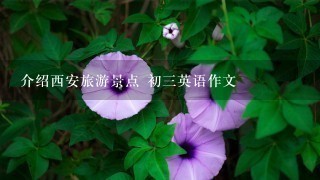
6、介绍西安旅游景点 初3英语作文
***.at the moment you walk into the gate of the park,the towering trees are welcoming you warmly with their luxuriant leave at each side of road.walking inside,you'll find a rockery garden line up with various kind of lovely posture,beckoning you walk nearer for appreciation.besides road ,the transparent lake is beating her waves at times as if welcome the tourist.while you overlook the landscape,the boundless lake is surrounding the hills and land makes you wonder the beauty of natural!xuanwu lake a unique scenery in Nanjin。





































































